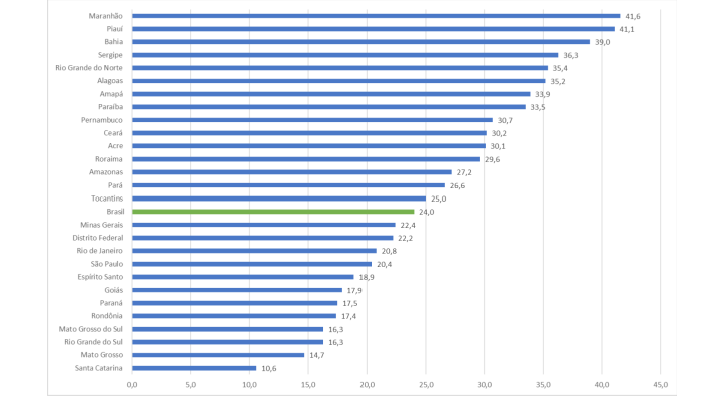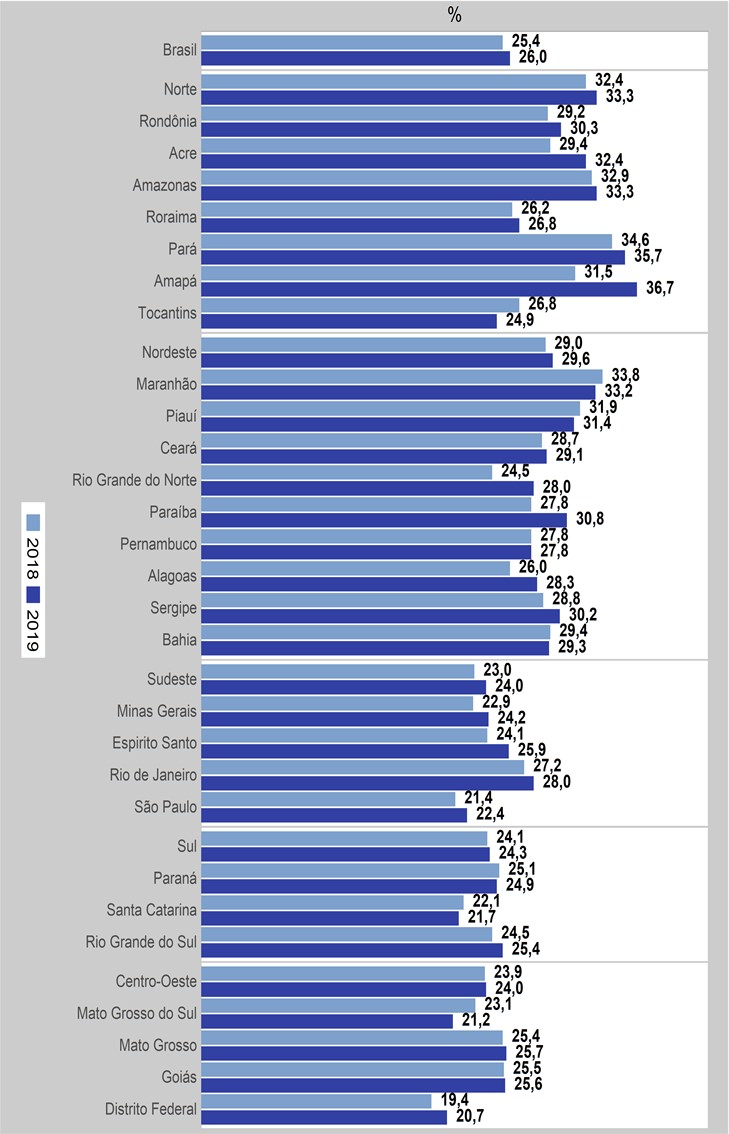Continuous PNAD, quarterly edition: unemployment holds steady in 25 of 27 FUs in Q3 2019
November 19, 2019 09h00 AM | Last Updated: November 27, 2019 01h01 PM
The unemployment rate in the 3rd quarter of 2019 was 11.8%, with a reduction of 0.2 percentage points (pp) in comparison with the 2nd quarter of 2019 (12.0%) and stability over the same quarter of 2018 (11.9%). Considering the statistically significant changes in relation to the previous quarter, the rate dropped in São Paulo (-0.8 pp) and increased in Rondônia (1.5 pp), remaining stable in the other 25 Federation Units. In relation to the same quarter of 2018, the rate increased in Goiás (1.9 pp) and Mato Grosso (1.3 pp). There were decreases in three UFs: São Paulo (-1.1 pp), Alagoas (-1.7 pp) and Sergipe (-2.8 pp), with stability in the other 22 Federation Units.
The highest rates were reported in Bahia (16.8%), Amapá (16.7%), and Pernambuco (15.8%) and the lowest in Santa Catarina (5.8%), Mato Grosso do Sul (7.5%) and Mato Grosso (8.0%).
In the 3rd quarter 2019, the compound rate of labor underutilization - percentage of unemployed persons or time-related underemployed persons or persons in the potential workforce in relation to the extended workforce - was 24.0%. Maranhão (41.6%) and Piauí (41.1%) posted estimates above 40%. On the other hand, the states where there were the lowest rates were: Santa Catarina (10.6%), Mato Grosso (14.7%), Rio Grande do Sul (16.3%) and Mato Grosso do Sul (16.3%).
The number of the discouraged in the third quarter of 2019 was of 4.7 million persons aged 14 and above. The largest contingents were in Bahia (781 thousand persons) and Maranhão (592 thousand) and the smallest ones in Roraima and Amapá, with 17 and 19 thousand persons, respectively.
The percentage of discouraged persons– in relation to the workforce or discouraged population – was estimated at 4.2% in the 3rd quarter of 2019. The greatest percentages were in Maranhão (18.3%) and Alagoas (16.5%) and the lowest ones were in Santa Catarina (1.1%), Rio Grande do Sul (1.3%) and the Federal District (1.3%).
The percentage of persons with a formal contract in the private sector in the country was of 73.6%. The highest percentage was in Santa Catarina (87.7%) and the lowest, in Maranhão (49.9%).
The percentage of workers without a formal contract in the private sector was of 26.4%. The FUs with the highest were Maranhão (50.1%), Pará (49.9%) and Piauí (49.9%) and the lowest rates were in Rio Grande do Sul (18.1%) and Santa Catarina (12.3%).
The percentage of the employed of the country working as self-employed was of 26.0%. The greatest percentages were recorded in Amapá (36.7%), Pará (35.7%) and Amazonas (33.3%). Whereas the lowest ones were in the Federal District (20.7%), Mato Grosso do Sul (21.2%) and Santa Catarina (21.7%).
In relation to the length of search, in Brazil 46.9% of the unemployed went job-searching from one month to less than one year and 25.2% for two years and over. In Brazil, 1.8 million of unemployed were searching for a job for less than a month, whereas 3.2 million were searching for 2 or more years. The support material of the survey is on the right corner of this page.
Bahia (16.8%) had the highest unemployment rate in the 3rd quarter of 2019
The unemployment rate in the 3rd quarter of 2019 was 11.8%, changing -0.2 percentage points (pp) in relation to the 2nd quarter of 2019 (12.0%) and presenting stability in comparison with the same quarter of 2018 (11.9%).
The biggest rates were reported in Bahia (16.8%), Amapá (16.7%), and Pernambuco (15.8%) and the lowest in Santa Catarina (5.8%), Mato Grosso do Sul (7.5%) and Mato Grosso (8.0%).
Considering the statistically significant changes in relation to the previous quarter, the rate dropped in São Paulo (-0.8 pp) and increased in Rondônia (1.5 pp), remaining stable in the other 25 Federation Units. In relation to the same quarter of 2018, the rate increased in Goiás (1.9 pp) and Mato Grosso (1.3 pp). There were decreases in three UFs: São Paulo (-1.1 pp), Alagoas (-1.7 pp) and Sergipe (-2.8 pp), with stability in the other 22 Federation Units.
Unemployment rate by FU, in Q3 2019, in relation to Q2 2019 and to Q3 2018
Maranhão (41.6%) has the highest labor underutilization rate
In the 3rd quarter 2019, the compound rate of labor underutilization was 24.0%. Maranhão (41.6%) and Piauí (41.1%) showed the biggest estimates, both above 40%. While Santa Catarina (10.6%), Mato Grosso (14.7%), Rio Grande do Sul (16.3%) and Mato Grosso do Sul (16.3%) were the states with the lowest rates.
Compound rate of labor underutilization in Q3 2019

Amapá (36.7%) has the highest percentage of self-employed
The percentage of the employed population of the country working as self-employed in the 3rd quarter of 2019 was of 26.0%.The biggest percentages were recorded in Amapá (36.7%), Pará (35.7%) and Amazonas (33.3%). In contrast, the lowest ones were in the Federal District (20.7%), Mato Grosso do Sul (21.2%) and Santa Catarina (21.7%).
Percentage of persons aged 14 or more, employed in the week of reference as SELF-EMPLOYED in the main occupation, by Major Regions and Federation Unit – 3rd quarter 2018/2019

Maranhão (50.1%) has the highest percentage of workers without a formal contract
The proportion of workers without a formal contract in the private sector of the country in the 3rd quarter of 2019 was of 26.4%. The Federation Units with the biggest percentages were Maranhão (50.1%), Pará (49.9%) and Piauí (49.9%) and the lowest rates were in Rio Grande do Sul (18.1%) and Santa Catarina (12.3%).
Santa Catarina (87.7%) has the highest percentage of workers with a formal contract
In the 3rd quarter of 2019, 73.6% of workers in the private sector had a formal contract. Among the Federation Units, Santa Catarina (87.7%), Paraná (80.8%) and Rio Grande do Sul (81.9%) had the biggest percentages, whereas the lowest ones were in Maranhão (49.9%), Piauí and Pará (both with 50.1%).
Unemployment rate is higher for women in all Major Regions
In the 3rd quarter of 2019, the unemployment rate was 11.8%. Regarding the sex category, the rate was 10.0% for men and 13.9% for women. Among the Major Regions, the biggest unemployed rate for women was reported in the Northeast (16.7%) and the lowest in the South (9.8%).
In the 3rd quarter of 2019, the employment-population ratio of men, in Brazil, was estimated at 64.6% and for women was 45.9%.The particular behavior of that indicator with differences between men and women was observed in the five Major Regions, especially in the North, which recorded the biggest difference in the indicator between the sexes (22.7 percentage points), and in the Southeast and in the South, with the smallest difference (18.0 percentage points).
Unlike what was seen for the employed population, the percentage of women in the unemployed population was higher than that for men. In the Q3 2019, women represented 53.3% of this population. In all the Major Regions, the percentage of women in the unemployed population surpassed that of men. In the Central-West Region, the percentage of women was the biggest, they represented 54.8% of the unemployed persons.
Unemployment rate of blacks (14.9%) and browns (13.6%) surpass the national average
The unemployment rate, disaggregated by color or race, showed that the rate of those self-declared white (9.2%) stood below the national average, though that of black (14.9%) and brown (13.6%) persons stood above it. In Q1 2012, when the average rate was estimated at 7.9%, that of black persons corresponded to 9.6%, 9.1% for browns and 6.6% for whites.
The contingent of unemployed persons in Brazil in Q1 2012 was estimated at 7.6 million persons, while the browns represented 48.9% of this population; next were the whites, 40.2%, and the blacks, 10.2%. In the 3rd quarter of 2019, this contingent increased to 12.4 million persons, and the brown people participation became 52.9%; that for the white ones decreased to 34.3%, and for the black population it increased to 12.8%.
In the quarterly comparison, earnings remain stable in 26 of the 27 Federation Units
The monthly average usual real earningsfrom all jobs, by persons aged 14 years and over, employed in the reference week, with income from labor, was estimated at R$2,298. That figure recorded stability both against the previous quarter (R$ 2,297) and against the same quarter a year before (R$ 2,295).
Among the Federation Units, only Rondônia reported changes (4.8 pp), rising from R$ 1,941 in Q2 2019 to R$ 2,035 in Q3 2019. All the other Major Regions registered statistically-stable figures in this indicator. The highest figure was registered in the Federal District (R$ 3,887) and the lowest in Maranhão (R$ 1,333).
Brazil has 3.2 million persons that went job-searching for 2 years or more
In relation to the length of search, in Brazil, in the 3rd quarter of 2019, 46.9% of the unemployed were searching for a job for one month to less than one year. Between 2012 and 2015, there was a reduction in the proportion of unemployed persons that went job-searching for 2 years or more. However, since 2016, this contingent has shown successive growth, reaching the highest percentage (25.6%) in Q3 2018 and decreasing to 25.5% in Q3 2019.
In absolute figures, 1.8 million of unemployed persons were searching for a job for less than a month, while 3.2 million were searching for it for 2 or more years (see the following table).

